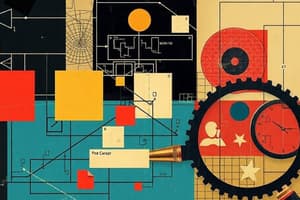Podcast
Questions and Answers
What is the primary purpose of a block diagram?
What is the primary purpose of a block diagram?
- To combine various data inputs into a single output.
- To illustrate relationships between principal parts or functions. (correct)
- To show detailed schematics of electronic devices.
- To represent an algorithm or workflow.
In what fields are block diagrams commonly utilized?
In what fields are block diagrams commonly utilized?
- Psychology and sociology.
- Mathematics and theoretical physics.
- Literature and arts.
- Engineering and process flow design. (correct)
How does a flowchart represent the steps of a process?
How does a flowchart represent the steps of a process?
- With circles and lines indicating flow direction.
- Using blocks with different colors for each step.
- In a linear format with no branching paths.
- As boxes connected by arrows indicating the order. (correct)
Which element is NOT typically found in a block diagram?
Which element is NOT typically found in a block diagram?
What distinguishes a flowchart from a block diagram?
What distinguishes a flowchart from a block diagram?
Flashcards are hidden until you start studying
Study Notes
Block Diagram
- Represents a system with principal parts or functions as blocks.
- Lines connecting blocks illustrate the relationships and interactions between components.
- Commonly used in engineering disciplines including hardware design, electronic design, software design, and process flow diagrams.
Flowchart
- A diagram that depicts an algorithm, workflow, or process visually.
- Steps of the process are represented as boxes of different shapes to signify various actions.
- Arrows connect boxes to show the sequence and order of steps.
- Serves as a solution model to address and resolve specific problems effectively.
Studying That Suits You
Use AI to generate personalized quizzes and flashcards to suit your learning preferences.




